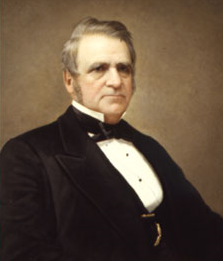Sanford E. Church
| Sanford E. Church | |
|---|---|
 |
|
| 19th New York State Comptroller | |
|
In office January 1, 1858 – December 31, 1859 |
|
| Preceded by | Lorenzo Burrows |
| Succeeded by | Robert Denniston |
| Lieutenant Governor of New York | |
|
In office January 1, 1851 – December 31, 1854 |
|
| Governor |
Washington Hunt Horatio Seymour |
| Preceded by | George W. Patterson |
| Succeeded by | Henry J. Raymond |
| Member of the New York State Assembly | |
|
In office January 1, 1842 – December 31, 1842 |
|
| Preceded by | Richard W. Gates |
| Succeeded by | Elisha Wright |
| Personal details | |
| Born |
Sanford Elias Church April 18, 1815 Milford, Otsego County, New York, U.S. |
| Died | May 13, 1880 (aged 65) Albion, New York, U.S. |
| Resting place | Mount Albion Cemetery, Albion, New York |
| Citizenship | United States |
| Political party | Democratic |
| Spouse(s) | Ann Wild Church |
| Children | Nellie Church George B. Church |
| Profession | Lawyer Judge Politician |
Sanford Elias Church (April 18, 1815 – May 13, 1880) was an American lawyer and Democratic politician. He served as Lieutenant Governor of the state of New York and chief judge of the New York Court of Appeals for a decade.
Born in Milford, Otsego County, New York, Church moved from Otsego to Monroe County, New York, with his parents when he was still a child, and his education was obtained in the common schools of that county and at the Monroe Academy. From 1835 on he resided in Albion, New York, with the exception of a brief residence in Rochester, New York.
Church studied law with Benjamin L. Bessac, and was admitted to the bar in 1842 and became Bessac's law partner until 1843. Then he associated himself with Noah Davis. This firm continued for a period of thirteen years. On its dissolution the firm of Church & Sawyer was established at Albion. About 1862, he took Judge Selden's place in the firm of Selden, Munger & Thompson, at Rochester; in 1865 the firm became Church, Munger & Cooke, and so continued until Church's elevation to the bench of the New York Court of Appeals.
Church was a member from Orleans County of the New York State Assembly in 1842. Three years later he was appointed District Attorney of Orleans County, and after the New York State Constitution of 1846 became effective, was elected by the people to the same office, serving until the end of 1850.
In 1850 Church was nominated by the Democrats for lieutenant governor with Horatio Seymour for governor. Seymour was defeated by Washington Hunt, the Whig candidate, by about two hundred majority, but Church ran ahead of his ticket and was elected. In 1852, he was re-elected to the same office, and this time Seymour was elected governor.
...
Wikipedia
